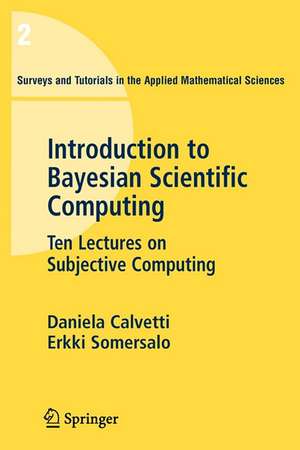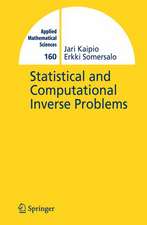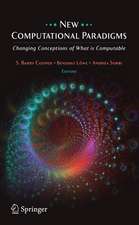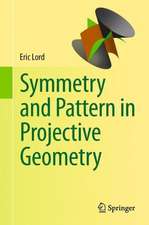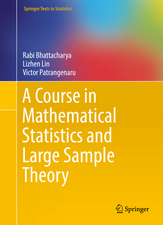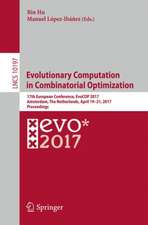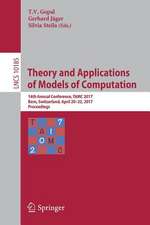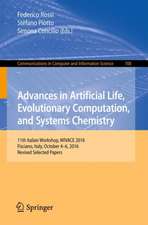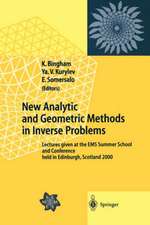An Introduction to Bayesian Scientific Computing: Ten Lectures on Subjective Computing: Surveys and Tutorials in the Applied Mathematical Sciences, cartea 2
Autor Daniela Calvetti, E. Somersaloen Limba Engleză Paperback – 26 noi 2007
Preț: 299.63 lei
Preț vechi: 374.54 lei
-20% Nou
Puncte Express: 449
Preț estimativ în valută:
57.34€ • 61.31$ • 47.80£
57.34€ • 61.31$ • 47.80£
Carte tipărită la comandă
Livrare economică 18 aprilie-02 mai
Preluare comenzi: 021 569.72.76
Specificații
ISBN-13: 9780387733937
ISBN-10: 0387733930
Pagini: 202
Ilustrații: XIV, 202 p.
Dimensiuni: 155 x 235 x 13 mm
Greutate: 0.3 kg
Ediția:2007
Editura: Springer
Colecția Springer
Seria Surveys and Tutorials in the Applied Mathematical Sciences
Locul publicării:New York, NY, United States
ISBN-10: 0387733930
Pagini: 202
Ilustrații: XIV, 202 p.
Dimensiuni: 155 x 235 x 13 mm
Greutate: 0.3 kg
Ediția:2007
Editura: Springer
Colecția Springer
Seria Surveys and Tutorials in the Applied Mathematical Sciences
Locul publicării:New York, NY, United States
Public țintă
ResearchCuprins
Inverse problems and subjective computing.- Basic problem of statistical inference.- The praise of ignorance: randomness as lack of information.- Basic problem in numerical linear algebra.- Sampling: first encounter.- Statistically inspired preconditioners.- Conditional Gaussian densities and predictive envelopes.- More applications of the Gaussian conditioning.- Sampling: the real thing.- Wrapping up: hypermodels, dynamic priorconditioners and Bayesian learning.
Recenzii
From the reviews:
"This witty, erudite, and surprisingly practical book is made up of ten chapters. … A central topic of the book is the relationship between statistical inference and the inverse problems that define Bayesian (subjective) statistics. … This excellent book will be valuable to scientists of various stripes, statisticians, numerical analysts, those who work in image processing, and those who implement Bayesian belief nets." (George Hacken, ACM Computing Reviews, Vol. 49 (11), November, 2008)
"Introduction to Bayesian Scientific Computing is a 200-page, easily accessible, pleasant introduction fusing Bayesian approaches with numerical linear algebra methods for inverse problems … . What I like most about this book is the apparent enthusiasm of the authors and their genuine interest in explaining rather than showing off. This enthusiasm is contagious, and the result is very readable." (Uri Ascher, The Mathematical Intelligencer, Vol. 31 (1), 2009)
"This witty, erudite, and surprisingly practical book is made up of ten chapters. … A central topic of the book is the relationship between statistical inference and the inverse problems that define Bayesian (subjective) statistics. … This excellent book will be valuable to scientists of various stripes, statisticians, numerical analysts, those who work in image processing, and those who implement Bayesian belief nets." (George Hacken, ACM Computing Reviews, Vol. 49 (11), November, 2008)
"Introduction to Bayesian Scientific Computing is a 200-page, easily accessible, pleasant introduction fusing Bayesian approaches with numerical linear algebra methods for inverse problems … . What I like most about this book is the apparent enthusiasm of the authors and their genuine interest in explaining rather than showing off. This enthusiasm is contagious, and the result is very readable." (Uri Ascher, The Mathematical Intelligencer, Vol. 31 (1), 2009)
Textul de pe ultima copertă
A combination of the concepts subjective – or Bayesian – statistics and scientific computing, the book provides an integrated view across numerical linear algebra and computational statistics. Inverse problems act as the bridge between these two fields where the goal is to estimate an unknown parameter that is not directly observable by using measured data and a mathematical model linking the observed and the unknown.
Inverse problems are closely related to statistical inference problems, where the observations are used to infer on an underlying probability distribution. This connection between statistical inference and inverse problems is a central topic of the book. Inverse problems are typically ill-posed: small uncertainties in data may propagate in huge uncertainties in the estimates of the unknowns. To cope with such problems, efficient regularization techniques are developed in the framework of numerical analysis. The counterpart of regularization in the framework of statistical inference is the use prior information. This observation opens the door to a fruitful interplay between statistics and numerical analysis: the statistical framework provides a rich source of methods that can be used to improve the quality of solutions in numerical analysis, and vice versa, the efficient numerical methods bring computational efficiency to the statistical inference problems.
This book is intended as an easily accessible reader for those who need numerical and statistical methods in applied sciences.
Inverse problems are closely related to statistical inference problems, where the observations are used to infer on an underlying probability distribution. This connection between statistical inference and inverse problems is a central topic of the book. Inverse problems are typically ill-posed: small uncertainties in data may propagate in huge uncertainties in the estimates of the unknowns. To cope with such problems, efficient regularization techniques are developed in the framework of numerical analysis. The counterpart of regularization in the framework of statistical inference is the use prior information. This observation opens the door to a fruitful interplay between statistics and numerical analysis: the statistical framework provides a rich source of methods that can be used to improve the quality of solutions in numerical analysis, and vice versa, the efficient numerical methods bring computational efficiency to the statistical inference problems.
This book is intended as an easily accessible reader for those who need numerical and statistical methods in applied sciences.
Caracteristici
Expository accessible book, internationally known authors Includes supplementary material: sn.pub/extras
